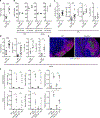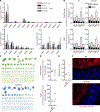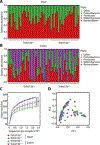Gut T cell-independent IgA responses to commensal bacteria require engagement of the TACI receptor on B cells
- PMID: 32737068
- PMCID: PMC8349226
- DOI: 10.1126/sciimmunol.aat7117
Gut T cell-independent IgA responses to commensal bacteria require engagement of the TACI receptor on B cells
Abstract
The gut mounts secretory immunoglobulin A (SIgA) responses to commensal bacteria through nonredundant T cell-dependent (TD) and T cell-independent (TI) pathways that promote the establishment of mutualistic host-microbiota interactions. SIgAs from the TD pathway target penetrant bacteria, and their induction requires engagement of CD40 on B cells by CD40 ligand on T follicular helper cells. In contrast, SIgAs from the TI pathway bind a larger spectrum of bacteria, but the mechanism underpinning their production remains elusive. Here, we show that the intestinal TI pathway required CD40-independent B cell-activating signals from TACI, a receptor for the innate CD40 ligand-like factors BAFF and APRIL. TACI-induced SIgA responses targeted a fraction of the gut microbiota without shaping its overall composition. Of note, TACI was dispensable for TD induction of IgA in gut-associated lymphoid organs. Thus, BAFF/APRIL signals acting on TACI orchestrate commensal bacteria-specific SIgA responses through an intestinal TI program.
Copyright © 2020 The Authors, some rights reserved; exclusive licensee American Association for the Advancement of Science. No claim to original U.S. Government Works.
Figures







References
-
- Fagarasan S, Kawamoto S, Kanagawa O, Suzuki K, Adaptive immune regulation in the gut: T cell-dependent and T cell-independent IgA synthesis. Annu Rev Immunol 28, 243 (2010). - PubMed
-
- Nakajima A, Vogelzang A, Maruya M, Miyajima M, Murata M, Son A, Kuwahara T, Tsuruyama T, Yamada S, Matsuura M, Nakase H, Peterson DA, Fagarasan S, Suzuki K, IgA regulates the composition and metabolic function of gut microbiota by promoting symbiosis between bacteria. J Exp Med 215, 2019 (2018). - PMC - PubMed
-
- Macpherson AJ, Yilmaz B, Limenitakis JP, Ganal-Vonarburg SC, IgA Function in Relation to the Intestinal Microbiota. Annu Rev Immunol 36, 359 (2018). - PubMed
-
- Hapfelmeier S, Lawson MA, Slack E, Kirundi JK, Stoel M, Heikenwalder M, Cahenzli J, Velykoredko Y, Balmer ML, Endt K, Geuking MB, Curtiss R 3rd, McCoy KD, Macpherson AJ, Reversible microbial colonization of germ-free mice reveals the dynamics of IgA immune responses. Science 328, 1705 (2010). - PMC - PubMed
Publication types
MeSH terms
Substances
Grants and funding
LinkOut - more resources
Full Text Sources
Research Materials
Miscellaneous

